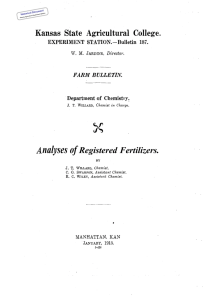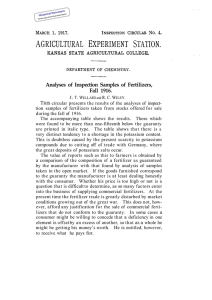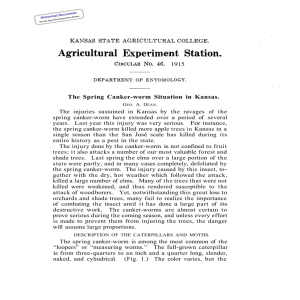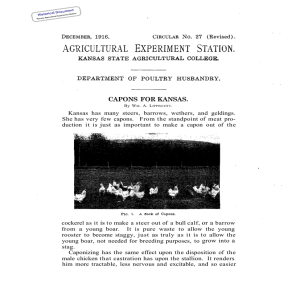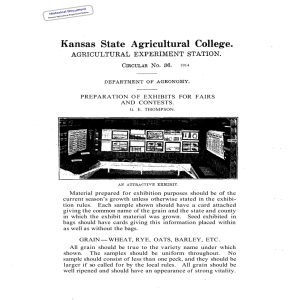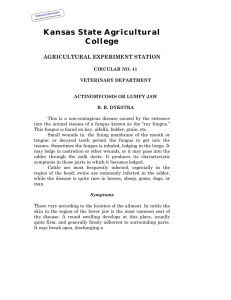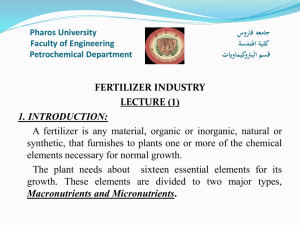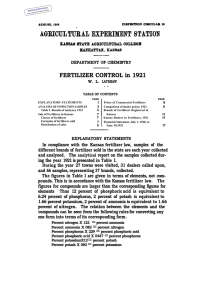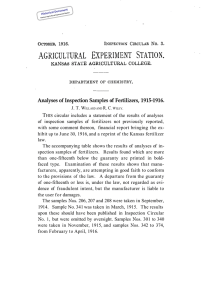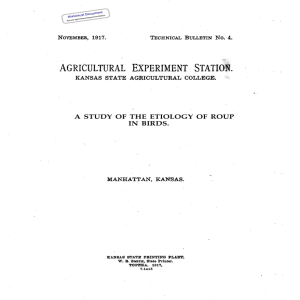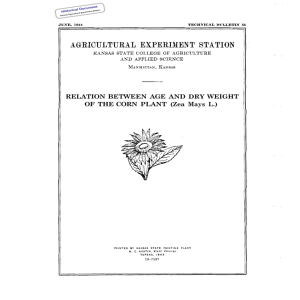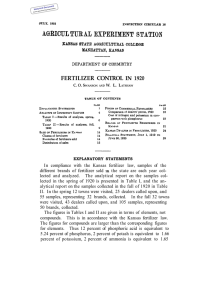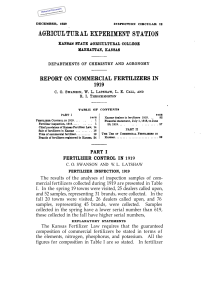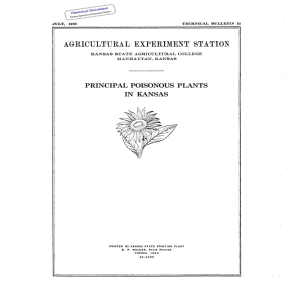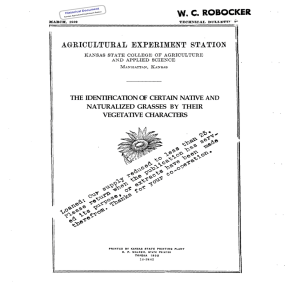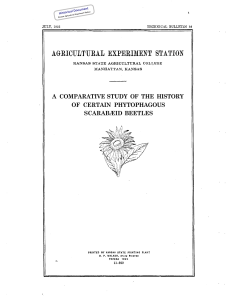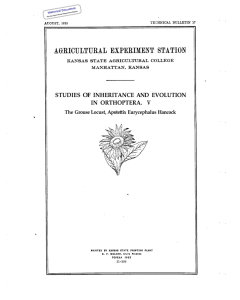Document 13273591
advertisement
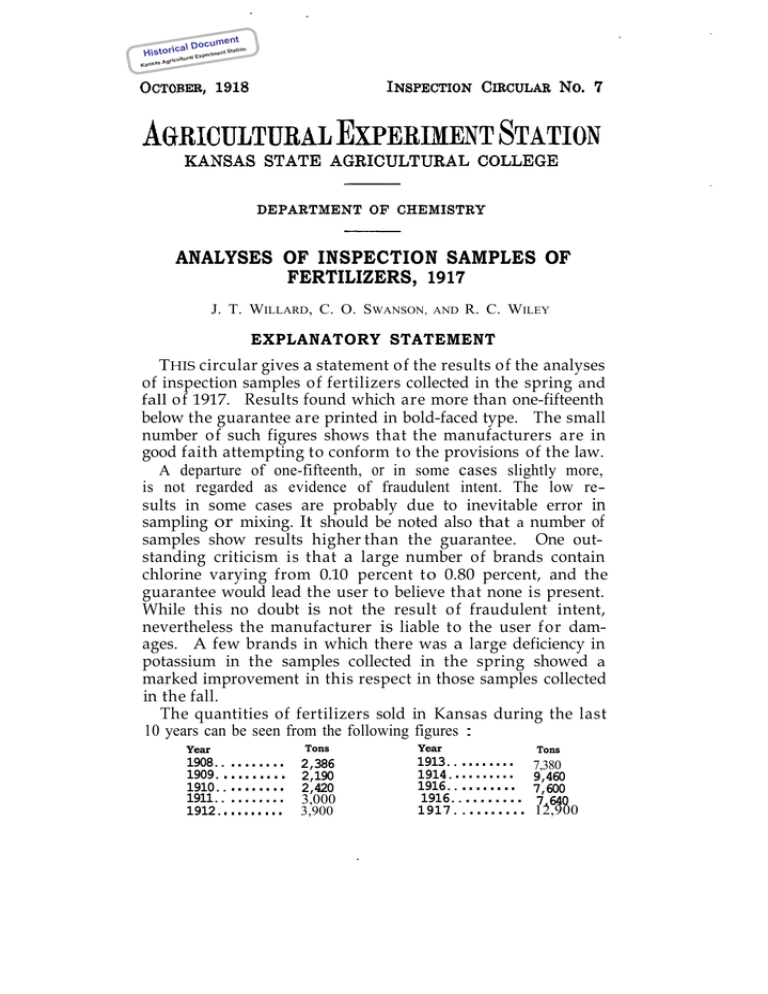
ument c cal Do Histori Kansas n t Statio perimen ral Ex ricultu Ag ANALYSES OF INSPECTION SAMPLES OF FERTILIZERS, 1917 J. T. WILLARD, C. O. SWANSON, AND R. C. WILEY EXPLANATORY STATEMENT THIS circular gives a statement of the results of the analyses of inspection samples of fertilizers collected in the spring and fall of 1917. Results found which are more than one-fifteenth below the guarantee are printed in bold-faced type. The small number of such figures shows that the manufacturers are in good faith attempting to conform to the provisions of the law. A departure of one-fifteenth, or in some cases slightly more, is not regarded as evidence of fraudulent intent. The low results in some cases are probably due to inevitable error in sampling or mixing. It should be noted also that a number of samples show results higher than the guarantee. One outstanding criticism is that a large number of brands contain chlorine varying from 0.10 percent to 0.80 percent, and the guarantee would lead the user to believe that none is present. While this no doubt is not the result of fraudulent intent, nevertheless the manufacturer is liable to the user for damages. A few brands in which there was a large deficiency in potassium in the samples collected in the spring showed a marked improvement in this respect in those samples collected in the fall. The quantities of fertilizers sold in Kansas during the last 10 years can be seen from the following figures : Year ........ ......... 1908.. 1909. 1910.. 1911.. 1912. ........ ........ ......... Tons 2,386 2,190 2,420 3,000 3,900 Year ........ ......... ........ ........ 1913.. 1914. 1916.. 1916.. 1917.. ........ Tons 7,380 9,460 7,600 7,640 12,900 t cumen cal Do ent Station Histori perim tural Ex ricul nsas Ag Ka These figures are based on the sale receipts of tax tags. This shows a constant increase, except for the temporary drop in 1916 and 1916. The amount used in 1917 was from five to six times the amount used eight or ten years ago. Commercial fertilizers are valuable because they contain the elements nitrogen, phosphorus, and potassium in forms quickly available for plant use. A soil which contains in 1 acre, 7 inches deep, 2,000 to 3,000 pounds of nitrogen, 500 to 800 pounds of phosphorus, and 20,000 to 30,000 pounds of potassium, may respond to the application of a few hundred pounds o f fertilizers. This is because these elements in the fertilizers are in a form more quickly available than the forms in which they are present in the soil. The principal sources of nitrogen in fertilizers sold in Kansas are: Slaughter house products, such as bone, blood, tankage ; sodium nitrate ; ammonium sulphate ; and animal manures. In compounds like sodium nitrate and ammonium sulphate, the nitrogen is available at once without any chemical change. In slaughter house products, the nitrogen is rapidly made available because these substances decay and undergo nitrification very quickly when put in the soil. The nitrogen in such animal manures as are put in fertilizers is no more quickly available than the nitrogen in the manure from the farmer’s barnyard, unless these manures have been subjected t o the “base mix” process. In this process inert nitrogenous materials are mixed with the acid phosphate at the time of manufacture. The heat and sulphuric acid act on the inert nitrogenous materials in such a way as to make the nitrogen more quickly available. Ordinarily, animal manures are not treated this way in the manufacture of fertilizers. The method of determining nitrogen in fertilizers does not make any distinction between the different forms. The figures as given in the tables represent the total. In most o f the fertilizers the source of nitrogen is slaughter house products. In a large number, dried animal manure is used as a filler. When this is done the manure also serves as a source of nitrogen. The sources of phosphorus in fertilizers are bone meal, tankage, and acid phosphate. Acid phosphate is made from rock phosphate by treatment with sulphuric acid. Generally speaking, 1 ton of finely ground rock phosphate is mixed with 1 ton of sulphuric acid and this gives 2 tons o f acid phosphate. If t cumen cal Do ent Station Histori ultural as Agric Experim Kans the rock phosphate contains 14 percent phosphorus the resulting acid phosphate would contain 7 percent phosphorus. The cost of the sulphuric acid, the cost of manufacture, the cost of added transportation, and the interest on the investment add to the cost of the phosphorus in acid phosphate. This additional cost must be met by the quicker returns from acid phosphate as compared with rock phosphate. Whether this will be done has been the subject of a great deal of controversy, and the relative merits are not discussed here. In the manufacture of acid phosphate a little less sulphuric acid is used than is needed to convert all the phosphorus in the rock phosphate to soluble forms. This is necessary in order to get a product that can be handled in transportation and subsequent use in the field. Because o f this, the phosphorus in acid phosphate is found in three different forms; namely, insoluble, reverted, and water-soluble. The insoluble is the form in which phosphorus is found in the original rock phosphate. The water-soluble is the form produced when the action in sulphuric acid has been carried to completion. This is the most available form. In the reverted form the action has not gone so far as in the water-soluble, but phosphorus in this form is available for the use o f crops. Some think that this form is as valuable as the water-soluble. By many fertilizer men the water-soluble and the reverted are classed together and called available. When this is done the “available” is simply the differencebetween the insoluble and the total. Phosphorus in bone and other slaughter house products is in a form that is quickly available. Raw bone contains fat and nitrogenous material. This is removed by water and heat. The resulting bone is very friable and can be ground to a very fine powder. In this form the phosphorus is quickly available. For this reason bone products are usually analyzed for total phosphorus only. Before the present war the source of potassium was the potash salts from Germany. These were usually the sulphate, chloride, and kainit. Kainit is a mixture o f several salts. The one common and important quality of the form of potassium in all of these salts is solubility in water. This is so important that no potassium is considered of value in fertilizers unless it is soluble in water. Since the outbreak of the war fertilizer manufacturers have had difficulty in obtaining materials con- t cumen cal Do ent Station Histori Kansas perim tural Ex Agricul taining potassium in suitable forms. Because of this difficulty the formula of a large number of brands has been changed so as to contain less potassium. Wood ashes and manure ashes are often used as sources of potassium. Such materials vary a great deal in composition. Nine samples of the fertilizers reported in this circular show a percent of potassium lower than the required minimum, while twenty-seven samples show a higher percent. This may be due to the difficulty of obtaining potassium-carrying materials of uniform composition. The increased use of fertilizers in 1917 over previous years is gratifying in that it shows an added effort in food production. But a word of warning should be given, not to discourage this increased use of fertilizers, but to encourage the full use of materials on the farm. A ton of alfalfa hay contains approximately 50 pounds of nitrogen, 50 pounds of potassium, and 3 pounds of phosphorus. A ton of average barnyard manure contains 10 pounds of nitrogen, 8 pounds of potassium, and 2 pounds of phosphorus. These materials also contain humus-forming material. This is absent in commercial fertilizers. A continued use of commercial fertilizers without the use of humus-forming materials, such as straw, barnyard manure, and crop residues, leads to the depletion of the humus present in the soil, and the result is lessened production because o f the bad physical condition which always follows humus depletion.¹ ument c cal Do Histori n t Statio perimen tural Ex Agricul Kansas t cumen cal Do ent Station Histori Kansas perim tural Ex Agricul ument c cal Do Histori Kansas riment Agric Expe ultural Station t cumen cal Do ent Station Histori Kansas perim tural Ex Agricul ument c cal Do Histori Kansas riment Agric Expe ultural Station t cumen cal Do ent Station Histori Kansas tural Agricul Experim t cumen cal Do ent Station Histori Kansas tural Agricul Experim ument c cal Do Histori riment ral Expe tu Agricul Kansas Station t cumen cal Do ent Station Histori Kansas tural Agricul Experim t cumen cal Do ent Station Histori Kansas perim tural Ex Agricul t cumen cal Do ent Station Histori Kans ultural as Agric Experim
